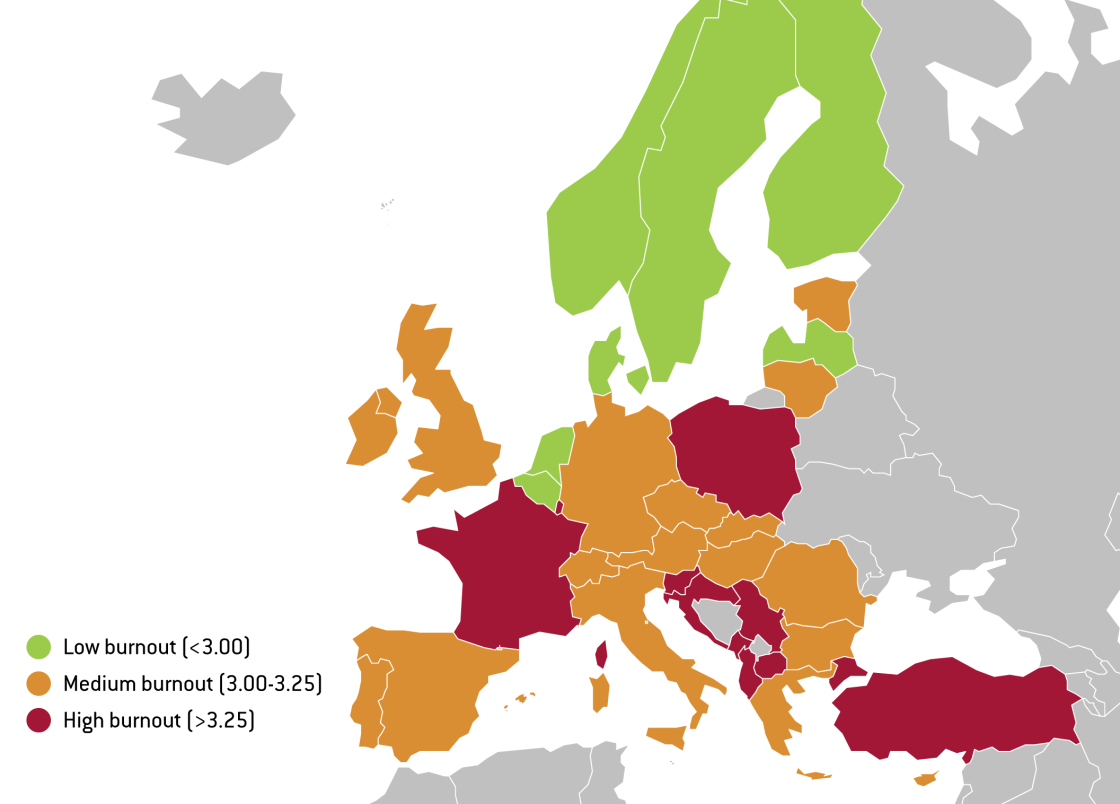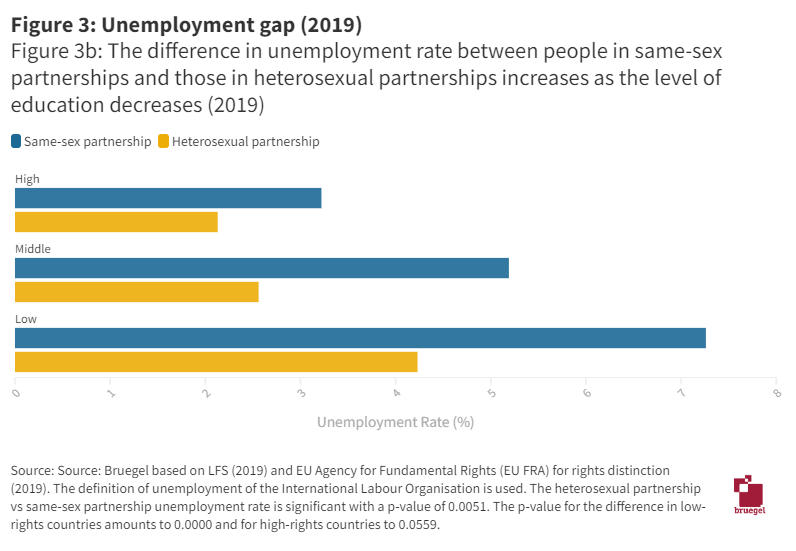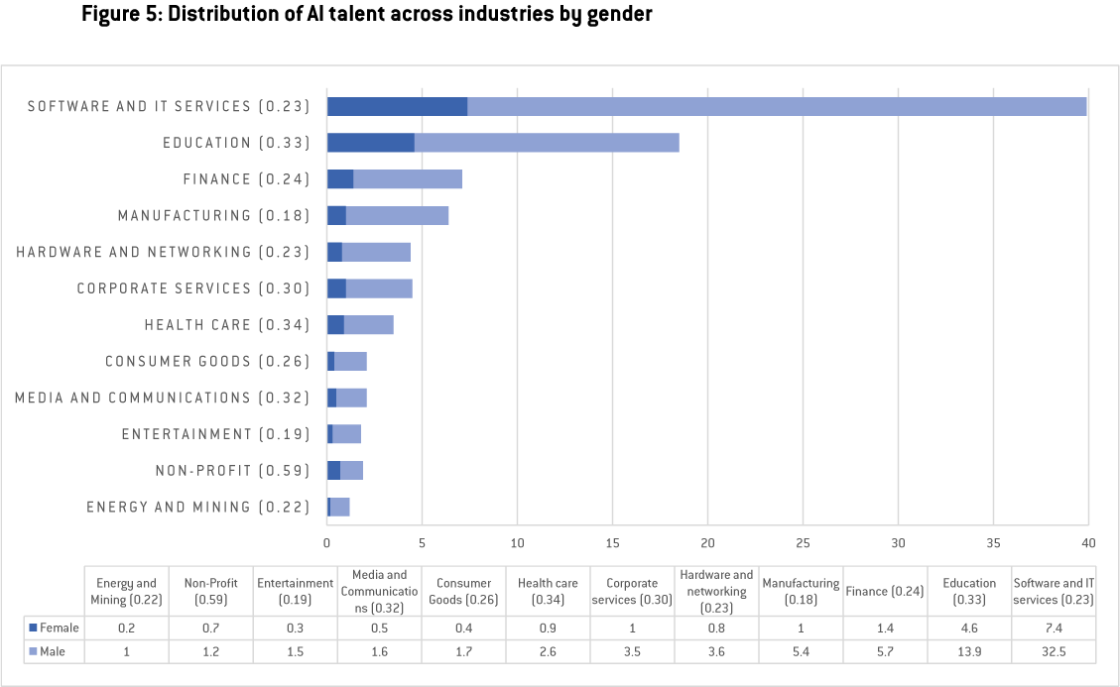Inclusive digital economy: a round-up of project research
The rise of automation, remote employment and a diversifying workforce will necessitate a shift in how we interact with new technology

Bruegel’s Future of Work and Inclusive Growth (FWIG) project took on the challenge of investigating how today’s job market can transform to meet the needs of the future economy. The combined rise of automation, remote employment, globalisation and a diversifying workforce will necessitate a generational shift in how we interact with, and collaborate around, new technology.
Over the course of this project, we have oriented our many projects around four themes: new ways of working; technology in the workforce; reskilling and mobility; and inclusive digital economy. This last grouping looks at the inequalities that accompany economic transformation, some longstanding and some tied to the same innovation that brings promise. Sexism, poor working conditions and other forms of discrimination have long kept economies from operating at full potential, as well as perpetuating inequities at odds with European societal values. It is therefore imperative that any study of new ways of working look at how technology-driven shifts affect women, minorities and unemployed young people. If the digital transformation can reduce the amount of bias in the economy, we will all be better off. If it perpetuates it, however, much is at stake.
One of the takeaways from this project is that policymakers should spend more time considering the quality, not just the quantity, of available jobs. Bruegel’s Laura Nurski and Mia Hoffman found that recurring economic crises have repeatedly shifted attention away from whether jobs that citizens can have are actually jobs worth having.
How is the labour market changing?
To get a sense of how the labour market is changing, Bruegel researchers assembled a Labour market outlook dashboard published in March 2024. The dataset covers labour trends since 2006 in all 27 European Union member countries and the bloc as a whole. In addition to giving an overview of unemployment rates and demographic breakdowns, the dashboard brings less-visible workforce trends to the surface.
This will help policymakers get a better sense of why something is happening, not just what – for example, when considering unemployment rates, the dashboard makes it easier to compare trends on why workers are out of work. Is it because they cannot find a job or have caregiving responsibilities? Or is it because they are discouraged or facing health care issues that keep them inactive even when they would prefer to be otherwise? The dashboard was created by affiliate fellow Duygu Güner, one of the leaders of the FWIG project, along with research assistants Giulia Gotti and Nina Ruer.
Job quality is the focus of a working paper by non-resident fellow Laura Nurski, also part of the FWIG project leadership, and former research analyst Mia Hoffman. In ‘Beating burnout: identifying bad jobs and improving job quality’, published in May 2022, they assemble a suite of evidence showing that poor working conditions are costing employers money and keeping the economy from growing at its full potential.
On average 11% of the EU workforce feels burnt-out, ranging from 4.3% in Finland to 20.6% in Slovenia. National statistics show that stress-related absenteeism has been rising, which hurts firms and places extra burden on government social supports. Even though it shows up at the individual level, burnout is an occupational phenomenon. High workloads and low autonomy are the most common predictors, leading to a syndrome of chronic workplace stress that becomes impossible to manage. In such a state of exhaustion, workers become disengaged, doubtful and cynical about the value of what they are doing.

Burnout has been notably acute across occupations within the healthcare and education sectors, exacerbated by new technologies that give employers more ways to control workers and keep track of their every move. In an accompanying podcast with Bruegel’s Giuseppe Porcaro, ‘Job quality is about more than working conditions’, Nurski and Hoffman note that surveillance itself creates stress and weakens the trust between employees and employers. This, combined with the way automation changes job roles, can have a big impact on how workers feel about their jobs and how they perform in those roles.
Changing jobs in Europe is still difficult and relatively low volume, which makes it harder to rely on the market to improve job quality without policy action. Furthermore, while researchers are studying job content trends and social relations in the workforce, policy has been centred around labour contracts and physical working conditions. Hoffman and Nurski note that physical conditions account for only about 4% of how people feel about their jobs, whereas role substance and social factors play much bigger roles.
There are costs to making bad jobs better: higher wages are an obvious expense, but there are other measures to help reduce bullying and improve safety that also require investments. That said, giving workers more autonomy could end up saving money, because more motivated and happier people are more productive at their jobs. Going forward, policymakers should take a more systematic look at burnout trends, make job quality a priority, and evaluate the effects of subsidies, training programmes and other interventions. With better data, it will be easier to see which sectors and regions have better outcomes and to share best practices across the EU.
Younger workers will face these questions most keenly in coming years, not just because they have more years ahead of them in the labour force but because they are having a harder time getting started on their career path. Even before the pandemic, youth unemployment in the European Union was three times higher than among the over-55s, the age cohort at the other end of their working lives. EU countries had been trying to address the disparity, but the COVID-19 shutdowns threatened to undo any progress, according to work by Bruegel Senior fellow Guntram Wolff and former research analyst Monika de Ridder.
In ‘The scarring effect of COVID-19: youth unemployment in Europe’, published November 2020, they found that youth unemployment rose during the second quarter of 2020, while unemployment for the older cohort was unchanged compared to a year earlier. Older workers had more professional experience and were able to hang onto their jobs, while younger workers faced substantial obstacles – the substantial increase in the proportion of under-25s not even seeking work, even though they are available to work, includes discouraged jobseekers and persons prevented from looking for work due to personal or family circumstances. Wolff and De Ridder called on the European Commission and national policymakers to urgently focus on supporting young people through hiring and training initiatives, not just macroeconomic policy.
Gender matters
Outsized pandemic’s effects were not limited to younger workers compared to older counterparts. The worldwide challenge also disproportionately hurt working women, compared to past recessions that took aim at jobs more commonly held by men. This difference in crisis effects requires appropriate steps in response, according to a paper by , former Bruegel Visiting fellow Estrella Gomez-Herrera of the University of Balearic Islands, Alexia Prskawetz of the Vienna Institute of Technology, the University of Vienna’s Sabine Theresia Köszegi and Caroline Berghammer.
In ‘Gender equality and reboundability in the labour market: lessons from COVID-19’, published December 2023, the authors noted that women are overrepresented in sectors that were hit severely by lockdowns, including hospitality, delivery of personal services and healthcare. Families had to organise home working, schooling, childcare and housework in parallel, also affecting women, given that traditional gender norms expect women to be the primary caregivers. Gender norms impact job segregation in labour markets and strongly affect the division of unpaid work.
Recognising gender equality as a determinant of societal resilience can provide policymakers with essential insights to guide them on the right path and the paper recommends further work in this area. Authorities need to do a better job designing measures that target structural gender equality, such as promoting equal sharing of care obligations, providing high-quality childcare institutions, and offering work-time flexibility. More resilient societies are better able to weather and rebound from shock and less stereotyped workforces are also more likely to reach their full potential.
Other gender-related factors are also holding the economy back. Bruegel consultant Tom Schraepen found that members of the gay, lesbian, bisexual and transgender communities are less likely to disclose their identities and orientations in less equitable societies. Even when they do disclose, there still is not enough data to draw clear conclusions on working conditions in the knowledge economy. His analysis ‘Do LGBTQIA+ people face EU labour market discrimination?’, published in September 2022, looks at trends in working conditions and related populations to assess what is happening and how policy can make it better.
At first glance, people in same-sex partnerships seem to have more managerial responsibilities, with higher levels of education and are in more skilled occupations. However, a closer look shows signs of discrimination: for example, research shows gay men are more likely to be in lower-level management positions than their heterosexual peers.
To try to get a sense of how these groups manage their careers, Schraepen used the EU Labour Force Survey constructing a group of people in same-sex partnerships and comparing them to people in heterosexual partnerships. This data showed that people in same-sex partnerships seem more likely to be unemployed than individuals in heterosexual partnerships, around 5.9% versus 4.6%. The overall finding becomes more pronounced when educational levels are taken into account: for workers with less education, the gap between people in same-sex partnerships and those in heterosexual arrangements widens. Furthermore, those in same-sex relationships were more likely to have left their last job for reasons not of their own choosing like being fired, having been made redundant or not having a contract extended.

In planning a strong future workforce, it will be important to make sure workers are not ruled out of certain jobs because of demographic factors. LGBTQIA+ community members are more likely to face disproportionate unemployment in countries that have fewer rights and protections. Automated hiring procedures and other new forms of workplace management need to avoid entrenching the worst parts of the current system.
Looking forward, gender matters must not be left out of efforts to understand how artificial intelligence is affecting the workforce. Left unchecked, digital inequality can spiral. In ‘How do gender stereotypes and gendered work segregation, and digitalisation and automation, result in a vicious cycle of digital gender inequality?’, published in August 2022, Gomez-Herrera and Köszegi emphasise that broad study of labour markets will not be enough.
Existing gender barriers hold women back at multiple levels, from the percentage of women pursuing science and engineering studies to their progress through a workforce that is too often systematically unwelcoming. Disparities in women's representation, remuneration and promotion make it extremely difficult to retain female talent in technology-related fields. A disproportionate number of women leave during their transition from higher education and career cycles.
This is bad for reasons that go beyond losing talented workers. Homogenous all-male developer teams are more likely to design AI systems and their applications in ways that perpetuate stereotypes and don’t meet user needs. Given that computing and AI jobs represent a significant proportion of EU employment, and the demand for these specialists is only expected to grow, this is cause for substantial concern. According to European Commission data, only 34% of STEM graduates and 17% of information and computer technology (ICT) graduates are female. Only 2.4% of female tertiary graduates earn ICT degrees versus 9.2% of male tertiary graduates.
Given the current talent shortage and the need to offer new skills to workers whose jobs are phased out by technology-related market shifts, policymakers need to turn their attention now to making AI and related careers more accessible to more people. The paper finds that a lack of data scientists and other experts is a main bottleneck holding up widespread adoption of AI technologies, and that this lack of AI skills could undermine Europe’s industrial prospects.

The AI revolution
Bruegel’s Porcaro looked into the link between AI and societal change with Nurski and Köszegi in an October 2021 podcast, ‘Is tech redefining the workplace for women?’ They explored the relationship between artificial intelligence and job transformation and whether the impact differs by gender. The scholars note that work is often segregated along gender lines and even societies where women are high educational achievers don’t take those gains into and throughout the workforce. It is important to ask whether increased use of technology will lower or exacerbate current discrepancies, and what actions can policy make to tip the scales in a more positive direction.
One issue is that studies generally tend to measure only the potential of automation, but do not consider other economic or practical factors that affect how and where new technology is adopted. As some jobs become more fully automated and disappear, others spring up to take their place. These trends combine with existing societal patterns that better paid, tech-intensive jobs tend to be more male dominated than lower-paid jobs that demand more physical and person-to-person duties. For example, in health care, the number of men increases as more tech is involved in providing care, and it will be important to keep tabs on whether this is happening across professions. If jobs become more presitigious and higher paid as they become more technology intensive and if women are pushed away from these jobs, it will make current imbalances worse and limit the available talent pool.
Robots add a physical dimension to these questions of technology and societal balance. Oxford Internet Institute’s Ekaterina Hertog and Bruegel Non-resident fellow Fabian Stephany joined Porcaro in the November 2023 podcast episode ‘Can/Should robots look after the young and the old?’, exploring the potential, ethics and the willingness of people to automatise unpaid domestic work. These cross-cutting questions affect not only employment trends but gender considerations, migration trends, service availability and work-life balance.
Privacy and opportunity cost are two of the big factors when assessing what can and cannot be automated. New technology is making these considerations more complex. For example, in the past, a washing machine might have increased privacy because it eliminated the need for a human assistant to enter a home, but the rise of Internet-connected setups means that the hired human might actually protect data better than a data collecting vacuum that sucks up not just dust but all kinds of personal information.
Stephany and Hertog discussed differences between the UK and Japan and among men and women in each society, on what can be automated. British men and Japanese women were more optimistic about technology than their counterparts, while Japanese men tended to worry about the cost of adopting new systems. Generally speaking, survey respondents were more likely to predict growing use of robots for cleaning, cooking and dishwashing than raising children or taking care of older family members.
If these robots turn out to work well as caregivers but come at significant cost, how should policy regulate who has access? Which households merit subsidies, and how else should authorities step in to make sure certain populations aren’t exploited in the process. That said, more automation could have radical implications for productivity because of all the time and resources that go into unpaid labour and other things that are important yet economically not measured.
Bruegel contributors Cristiano Codagnone and Maria Savona, who hold multiple academic affiliations in Spain, the UK and Italy, found that digital automation already has had broad effects on working conditions, not just on job loss and job creation. In ‘The hidden inequalities of digitalisation in the post-pandemic context’, published in January 2023, they delve into the more hidden impacts of technology adoption on employment, particularly on the invisible conditions of some jobs. These effects could represent a substantial social cost, particularly in the aftermath of the financial crisis and the COVID-19 pandemic, given the rise of non-standard work, remote work and more stressful job conditions in many fields. Mental health plays a big role in how workers approach their jobs and welfare considerations go beyond administrative differences in which jobs are classified as full time employment versus independent, part-time or otherwise outside traditional models.
Authorities could do more to provide social protections against job loss, sickness and other life circumstances, independently of employment status. The authors recommend that workers with non-standard employment, whose numbers are increasing, should have more access to social protection, such as through portable benefits attached to the worker rather than the job, or the establishment of ‘underemployment insurance’ to smooth out fluctuating incomes in the gig economy. Although more evidence is needed to investigate trade-offs, it seems clear that occupational safety and health risks are rising in part because of digitalisation. To make the digital future work for everyone, policymakers and communities must tackle the digital divide and address labour market inequalities.



